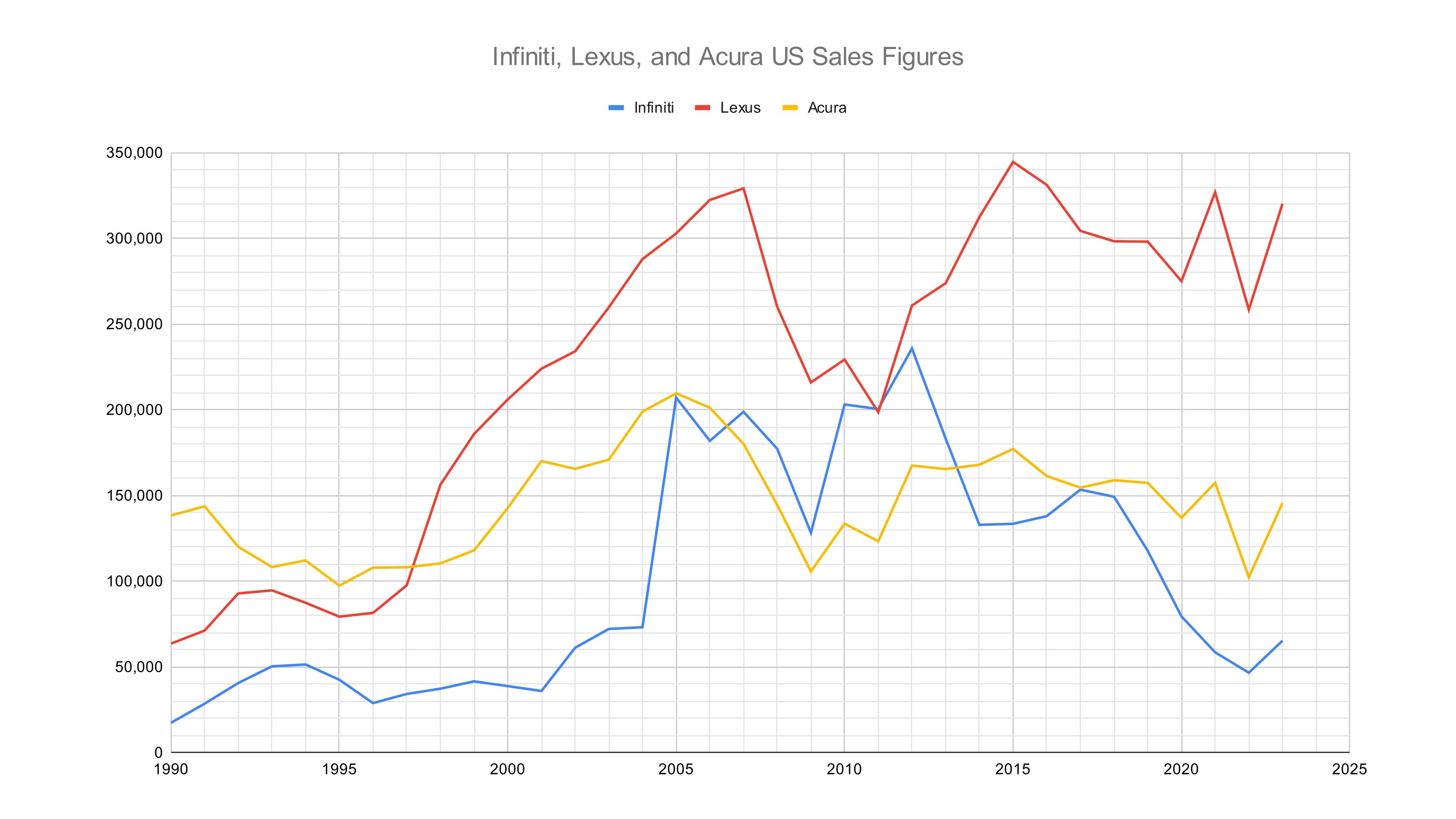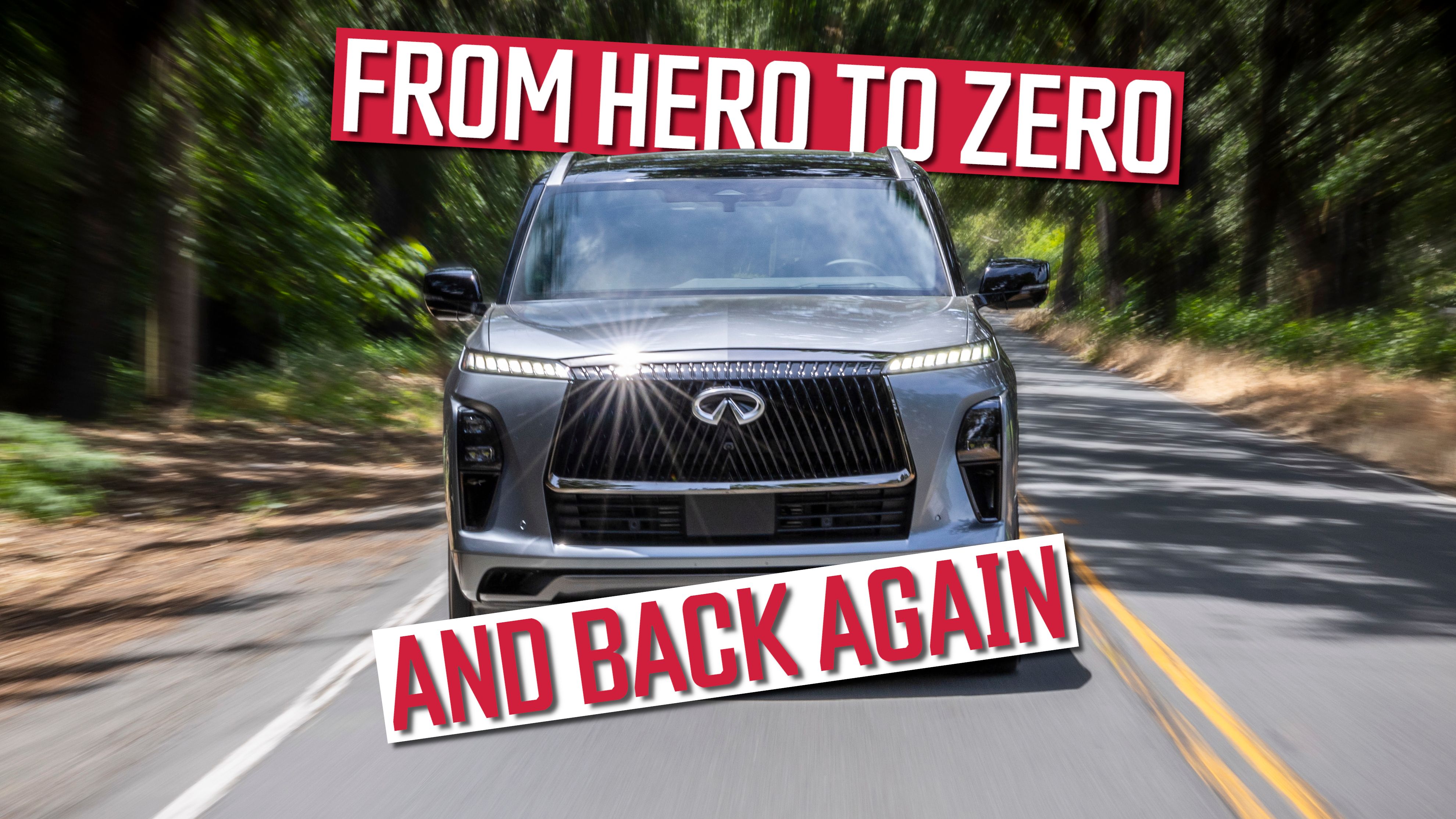
Everyone Wrote Them Off But Infiniti is Making A Glorious Comeback
Key Takeaways
- Infiniti’s sales have struggled compared to Lexus, with a peak in 2005 but declining since then.
- The brand rose to success in the early 2000s with models like the G35, but has since faced challenges.
- Infiniti is aiming for a comeback with a massive product onslaught, including potential EV offerings in the future.
Nissan launched its Infiniti luxury brand for the North American market back in 1989, the same year Toyota created its Lexus division. While Lexus has seen a steady increase in sales since its debut, Infiniti has struggled with numerous ups and downs. Whereas Lexus sales remain competitive with German automakers like BMW and Mercedes-Benz, Infiniti’s volume has dwindled to the point where it’s now an afterthought.
What happened to Infiniti? It was once a proving ground for Nissan’s most exciting platforms and powertrains. However, it has since been reduced to selling outdated products sitting on the market for years without significant overhauls.
In speaking with company leadership, CarBuzz has learned that Infiniti is ready to turn its fortunes around; brand executives have used words like “renaissance” and “comeback” to describe the upcoming product onslaught. To discover how close Infiniti is to staging a fully-fledged return to greatness, we sampled three products from various stages of the product cycle: one aging rapidly, one semi-recent and competitive, and one brand-new. These three vehicles show how far Infiniti has come and how far it may still need to go.
|
Infiniti US Sales Vs. Lexus/Acura (1990-2001) |
|||
|---|---|---|---|
|
Year |
Infiniti |
Lexus |
Acura |
|
1990 |
17,382 |
63,594 |
138,344 |
|
1991 |
28,561 |
71,206 |
143,708 |
|
1992 |
40,628 |
92,890 |
120,100 |
|
1993 |
50,364 |
94,677 |
108,291 |
|
1994 |
51,444** |
87,419 |
112,137 |
|
1995 |
42,520 |
79,334 |
97,451 |
|
1996 |
28,910 |
81,529 |
107,908 |
|
1997 |
34,252 |
97,593 |
108,143 |
|
1998 |
37,299 |
156,260* |
110,392 |
|
1999 |
41,595 |
185,890 |
118,006 |
|
2000 |
38,819 |
206,037 |
142,681 |
|
2001 |
35,973 |
223,983 |
170,109 |
Infiniti started shipping cars to the US in 1989, with 1990 being the first full year of sales. Two models were available at the time: a full-size sedan called the Q45 (based on the Nissan President) and a two-door coupe called the M30 (based on the Nissan Leopard). Infiniti sold just 17,382 units in its first full year, trailing far behind Lexus, which sold 63,594 units of its LS 400 and ES 250 sedans. Acura, Honda’s luxury division, already had a four-year head start in the market and sold 138,344 cars with the Legend, Integra, and NSX. Lexus added the SC in 1991, which easily outgunned the M30, and sales truly took off in 1998 with the arrival of the RX crossover*, helping pass Acura in sales for the first time. The RX became the company’s bestseller just one year later and has never relinquished that title.
To better compete with Acura and Lexus, Infiniti launched a slew of new models in the ’90s. These include several rebadged Japanese Domestic Market Nissan models like the G20 (based on the Nissan Primera), the second-generation M (now based on the Nissan Gloria), the second-generation Q45 (now based on the Nissan Cedric), and the J30 (based on the Nissan Leopard). Infiniti even took a page from Honda and Toyota’s playbook by selling nicer versions of Nissan vehicles available in America, such as the I30 (based on the Nissan Maxima) and QX4 (based on the Nissan Pathfinder).
None of the Japanese imports or domestic reskins ever helped Infiniti reach its true greatness. Sales peaked in 1994 at 51,444**, then hovered in the low 30-40,000 range until 2001. Then, one year later, everything changed.
The “Glory Days” Of Infiniti
|
Infiniti US Sales Vs. Lexus/Acura (2002-2011) |
|||
|---|---|---|---|
|
Year |
Infiniti |
Lexus |
Acura |
|
2002 |
61,188 |
234,109 |
165,552 |
|
2003 |
72,172 |
259,755 |
170,918 |
|
2004 |
73,159 |
287,927 |
198,919 |
|
2005 |
207,129* |
302,895 |
209,610 |
|
2006 |
181,887 |
322,434 |
201,223 |
|
2007 |
198,844 |
329,177 |
180,104 |
|
2008 |
177,271 |
260,087 |
144,504 |
|
2009 |
128,263 |
215,975 |
105,723 |
|
2010 |
203,107 |
229,329 |
133,606 |
|
2011 |
200,465** |
198,552 |
123,298 |
2002 marked the beginning of what we lovingly refer to as the “Glory Days” of Infiniti. This era was sparked by the arrival of possibly the most important Japanese luxury car to arrive stateside since the original Lexus LS, the Infiniti G35. Unlike its front-wheel-drive predecessor, the G20, the G35 was rear-wheel-drive, based on the iconic Nissan Skyline, a model made famous by its hardcore GT-R variants but was never imported to the US. The G35’s FM platform was shared with the Nissan 350Z sports car, as was its 3.5-liter VQ35DE engine with up to 282 horsepower, far more than the non-M BMW 3 Series produced at the time, and at a lower price point.
Sparked by the arrival of a BMW-rivaling sports sedan/coupe that was well-received by customers and critics at the time, Infiniti sales jumped by over 70% in 2002, totaling 61,188 units. Infiniti continued to break its own sales record for two more years before hitting its then-peak at 207,129 units in 2005*, heavily influenced by the G35, which sold 68,728 units that year. Acura and Lexus still led Infiniti with 209,610 and 302,895 units, respectively, but for the first time in the history of these three Japanese luxury brands, it was a close contest. By 2007, Infiniti overtook Acura in sales and managed to hold that lead until 2013. Nissan’s luxury arm then managed to achieve the impossible by outselling Lexus in 2011** with 200,465 units (Lexus had a down year with 198,552).
Infiniti thrived during this era because it learned from the G35 and its successor, the G37. American buyers wanted a premium car with a luxury badge, a lower price tag, improved reliability over European brands, and sporty yet comfortable handling. This period saw the launch of Infiniti’s best models: the FX (a rear-drive crossover that doesn’t receive enough credit for launching the coupe SUV trend), the third-generation M (a gorgeous, fully-fledged BMW 5 Series fighter), and the QX56 (a full-size Cadillac Escalade rival based on the Nissan Armada).
Infiniti couldn’t maintain its momentum forever; it never outsold Lexus again after 2011 and has trailed Acura every year since 2014.
Throwing The Brand Away
|
Infiniti US Sales Vs. Lexus/Acura (2012-2018) |
|||
|---|---|---|---|
|
Year |
Infiniti |
Lexus |
Acura |
|
2012 |
235,788* |
260,840 |
167,474 |
|
2013 |
183,228 |
273,847 |
165,436 |
|
2014 |
132,920 |
312,389 |
167,943 |
|
2015 |
133,498 |
344,601 |
177,165 |
|
2016 |
137,970 |
331,228 |
161,360 |
|
2017 |
153,415 |
304,376 |
154,602 |
|
2018 |
149,280 |
298,302 |
158,934 |
The end of Infiniti’s heyday coincides almost perfectly with an executive hire that shunted the brand. Johan de Nysschen was appointed CEO in 2012 but only stayed with Infiniti until 2014. During his short time there, he changed the brand’s trajectory to this day. Coming hot off the heels of Infiniti’s best-ever sales year*, he decided to rename the entire lineup, with sedans and coupes getting the Q name and crossovers and SUVs going by QX. Now-familiar nameplates like G37 and FX37/FX50 were thrown away, all to help Infiniti cater more towards European luxury car buyers. What followed was a precipitous sales drop that Infiniti hasn’t been able to end.
Related
Infiniti Q50 Generations: Everything You Need To Know In One Place
Infiniti’s compact premium sedan has been soldiering on with the same basic design for more than a decade and is now sorely in need of a replacement.
The Infiniti Q50 was the first all-new model to launch De Nysschen’s fresh naming scheme in 2013 with the near-impossible task of replacing the excellent G37. It was still Skyline-based, like the original G35, but it launched using the same 3.7-liter V6 engine as the outgoing G37, which was considered outdated by then. There was also a short-lived Q50 Hybrid and a Mercedes-powered four-cylinder model, but Infiniti eventually landed on the engine that’s still found under the hood today, a 3.0-liter twin-turbo V6 known as the VR30DDTT. Remember that engine code, as it will be important later on.
We recently drove a 2024 Infiniti Q50 Sedan, and despite being on the market for more than 10 years, it hasn’t changed much. A “second-generation” model was launched in 2016 with adaptive steering, a 400-hp Red Sport 400 model, and revised styling, but it never recaptured the magic of the G35/G37. Infiniti always teased us with concept cars like the Eau Rouge Prototype, a Q50 powered by a GT-R engine to challenge the BMW M3, but nothing ever materialized. It may have wireless Apple CarPlay, but the 2024 Q50 now feels utterly outdated in a market where sedans are already struggling to sell. The lone bright spot of this car is the VR30 engine, which helps the Red Sport AWD model achieve 60 mph in 4.5 seconds (4.94 seconds in CarBuzz testing). That’s quicker than an Acura TLX Type S and barely behind the V8 Lexus IS 500.
The Q50 wasn’t the best starting point for a soft Infiniti reboot, and the rest of the renamed lineup wasn’t much better. Though they weren’t new like the Q50, the M was rebadged as the Q70, and the G37 Coupe was spun off into the Q60. On the SUV side, the EX became the QX50, the FX turned into the QX70, the JX changed to the QX60, and the QX56 morphed into the QX80. Infiniti even kept the G37 around (now called the Q40) as a cheaper alternative to the Q50. Despite all receiving new nameplates, most of these vehicles felt long in the tooth and time, and none of them would receive generational changes until half a decade later.
Struggling To Bounce Back
|
Infiniti US Sales Vs. Lexus/Acura (2019-2023) |
|||
|---|---|---|---|
|
Year |
Infiniti |
Lexus |
Acura |
|
2019 |
117,708 |
298,112 |
157,385 |
|
2020 |
79,503 |
275,042 |
136,982 |
|
2021 |
58,555 |
326,928 |
157,408 |
|
2022 |
46,616 |
258,434 |
102,306 |
|
2023 |
65,316 |
320,249 |
145,655 |
Not counting the QX30, a short-lived small crossover based on the Mercedes GLA, the QX50 was the next model to get a major update in the 2019 model year. No longer a mini FX with RWD, the QX50 adopted a front-drive architecture with a brand-new turbocharged four-cylinder. It also spawned a “coupe” version in 2021 called the QX55, which acted as a spiritual successor to the FX. Despite Infiniti mentioning the FX in the marketing for the QX55, that message never felt genuine thanks to the continuously variable transmission, which made both models feel less premium than competitors from Europe and Japan.
Despite being Infiniti’s freshest model in one of the hottest luxury segments, the QX50 was repeatedly outsold by the larger QX60, which remained virtually the same as the JX35 (introduced in 2012) up until the 2022 model year. We recently drove a 2024 Infiniti QX60, which is a continuation of the second-generation model that debuted a few years ago. It’s still based on the same platform as the Nissan Pathfinder and uses a less-than-fresh 3.5-liter V6 engine, but it ditches the outgoing model’s CVT in favor of a superior nine-speed automatic. The QX60 feels perfectly modern inside, unlike its predecessor, and it includes Infiniti-first features like massage seats. It may not be above and beyond the best in its class, but it’s at least competitive with the Acura MDX and Lexus RX. Sadly, even a solid product like the QX60 hasn’t brought Infiniti back to its former glory; brand sales are currently hovering at pre-G35 levels.
Infiniti Renaissance Starts With QX80
The QX60 felt like Infiniti’s first step in the right direction since the renaming fiasco in 2014. But while the QX60 marked a positive but forgettable baby step, the 2025 Infiniti QX80 feels more like a giant leap back to the company’s glory days. The QX80 may be Infiniti’s flagship, but it was also the company’s oldest vehicle, having last been redesigned in 2010. This third-generation model has been desperately needed for years, and it arrives with a now-familiar engine, the twin-turbo V6 from the Q50 bored out to a 3.5-liter (dubbed the VR35DDTT).
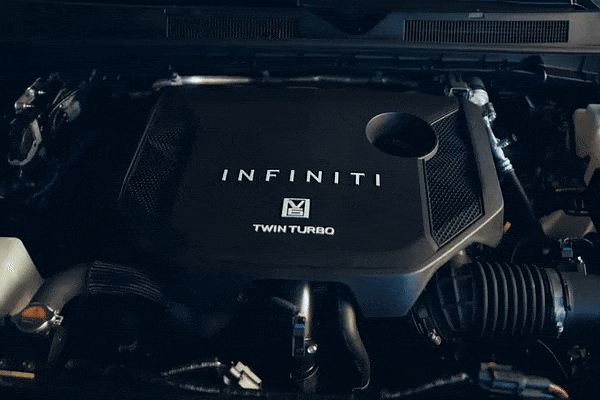
Related
2025 Infiniti QX80 Getting New Nissan GT-R-Related V6 Engine
Bye-bye V8, hello boost!
The VR30 may not have helped the Q50 outsell its predecessor, but the VR35 seems well-suited to take on the full-size SUV segment head-on. 450 hp and 516 lb-ft of torque represent increases of 50 and 103, respectively, over the outgoing 5.6-liter V8. It’s also enough to outmatch every engine in its category besides the twin-turbo Hurricane inline-six in the Jeep Grand Wagoneer. Infiniti managed to match the brawn with plenty of brains, as the QX80 boasts features that aren’t available in the segment-leading Cadillac Escalade. The QX80 boasts heated and ventilated massage seats in the second row, a feature matched only by the Lincoln Navigator. There’s even a heated third row.
Though it trails behind the American hands-free alternatives, the QX80 is also the first Infiniti to get ProPilot Assist 2.1 with hands-free driving. We’d easily recommend it if you want a luxury full-size SUV.
The 2025 QX80 represents exactly what made Infiniti great in the mid-2000s: European luxury and style at a lower price point. There’s just one problem. The QX80 arrives during a period of high gas prices as other brands pivot quickly to electric vehicles. Is this the right vehicle at the wrong time?
Will Electric Vehicles Save Infiniti?
The QX80 will be a great flagship product, reintroducing the world to the idea of an Infiniti that matches its luxury contemporaries with no asterisks. Sadly, Infiniti can’t bank on this model to reinvigorate sales since it has never sold more than 20,000 units per year since the QX56 days. Infiniti desperately needs a fresh lineup, and help is on the way.
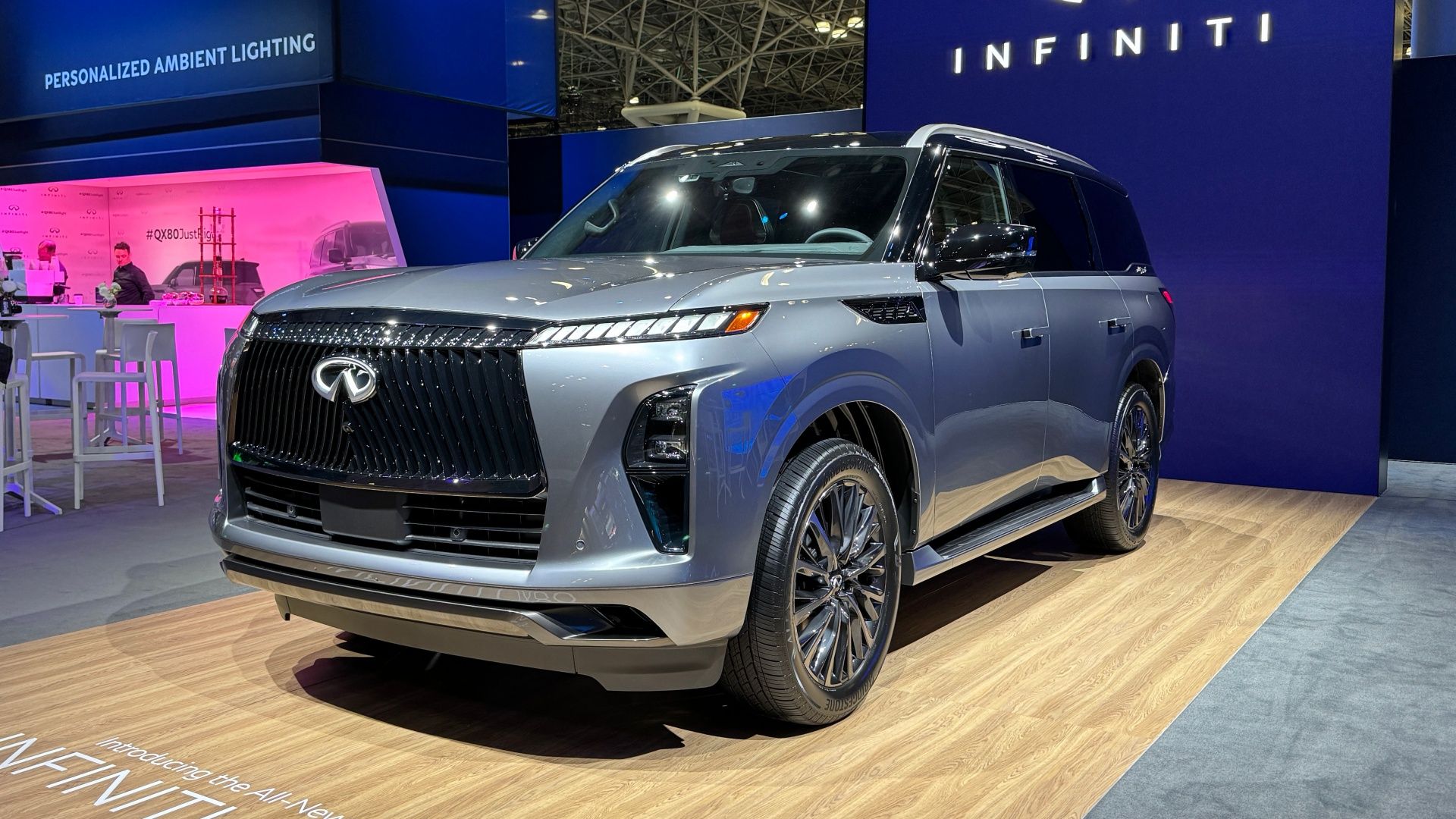
Related
Infiniti Knows It Needs To Be Faster With Releasing New Models
Letting a model sit for 14 years just can’t happen in today’s market.
Brand leadership knows it can’t let products sit on the market for over a decade without making major changes, and the evidence should show up in showrooms very soon. A new two-row SUV called the QX65 will join the lineup, using the QX60 as its underpinnings. To coincide with the QX65’s launch, Infiniti will also give the QX60 a mid-cycle refresh. Infiniti will finally join the electrified era with two full BEVs. The former will be a sedan based on the Vision Qe Concept, while the latter will be a crossover. We expect the sedan to share a lot in common with the Nissan Maxima and the crossover to be similar to the next-generation Leaf. Both will be built in Canton, Mississippi, so they should be eligible for a tax credit.
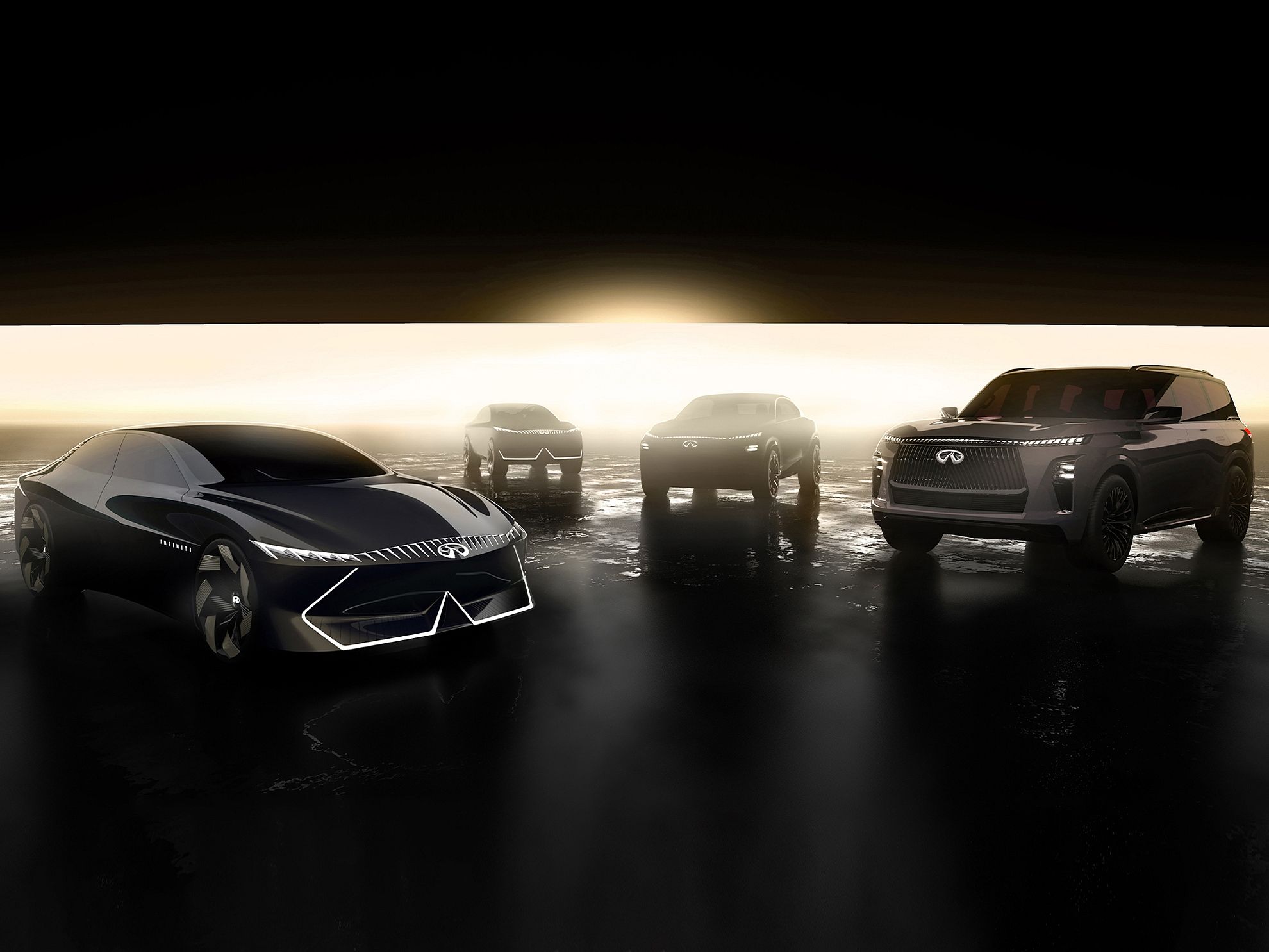
Related
Infiniti Teases Four Models That Will Revive The Luxury Brand
Is this the renaissance Infiniti has needed?
Infiniti faces an uphill battle, being so late to the EV market. Both Acura and Lexus already have EVs on sale (although the ZDX was built in partnership with General Motors), and Tesla still sells more EVs than all other automakers combined. If anything, Infiniti’s mountain to climb is even steeper than it was at the turn of the millennium. There’s no way Infiniti will ever be a threat to Tesla, but perhaps it can steal sales away from other brands. If Infiniti can launch semi-affordable EVs with competitive range, power, and charging speed, the brand might restore itself back to its glory days. Will the Infiniti brand renaissance be successful? Let’s watch and see.

